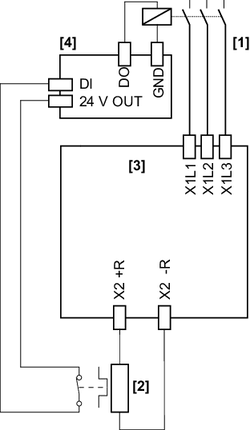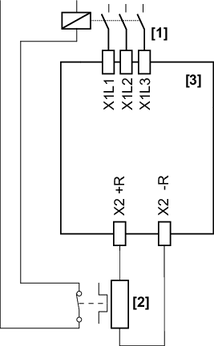Inverters of size 4 and larger
If a BW...-T braking resistor with internal temperature switch is used with these inverters, then 3 connections are possible:
Connection 1 | Connection 2 | Connection 3 |
|---|---|---|
|
|
|
[1] | Line contactor | [2] | Braking resistor | [3] | Inverter | [4] | PLC |
INFORMATION

When using connection variant 1 (connection of braking resistor without line contactor), the inverter must be supplied with external DC 24 V.
- Connection 1
- The digital input of the inverter connected to the signal contact of the internal temperature switch must be parameterized to the function "External braking resistor fault".
- If the thermal circuit breaker trips, the signal is evaluated in the inverter.
- A response by the PLC is not required.
- It is not necessary to disconnect the line connection using an external switching device.
- If an internal short circuit in the brake chopper is detected by the inverter, the inverter interrupts the energy supply by inhibiting the rectifier.
- If the thermal circuit breaker trips, the inverter switches all axis modules to "Output stage inhibit".
- Connection 2
- If the thermal circuit breaker trips, the signal is evaluated only in the PLC.
- If the thermal circuit breaker trips, the PLC must interrupt the power supply.
- If the thermal circuit breaker trips, there is no direct response in the inverter.
- With connection 2, it is possible that the PLC finishes the current travel cycle although the thermal circuit breaker has tripped. Only then is the power supply disconnected. In this case, the residual braking energy WRest = PBRnom × 20 s must not be exceeded.
- Connection 3
- If the thermal circuit breaker trips, the signal directly affects the line contactor.
- A response by the PLC is not required.
- If the thermal circuit breaker trips, there is no direct response in the inverter.


